About the Yellow Mongoose |
||
Introduction The Yellow Mongoose (Cynictis Pencilliata) is a member of the Herpestidae (mongoose) family. It has a body length of 23-33cm (9-13 inches), with an additional 18-25cm (7-10 inches) for the tail, and weighs between 450-800 grams. It is exclusive to the semi-deserts, scrublands and grasslands of Namibia, Botswana, Angola, Zimbabwe, western Traansaval, northern Natal and South Africa, where it lives in groups, called colonies, of 5 - 20 individuals. These groups generally consist of a single breeding pair, their offspring and their relatives. How the breeding pair monopolises mating rights is yet to be studied. The Yellow Mongoose is generally active by day, particually during the cool evenings, but it has been seen at night. When it's time to sleep, the yellow mongoose retires to the safety of a burrow which, more often than not, belong to another animal. On occasions they will share their den with meerkats and ground squirrels. Yellow Mongooses travel on four feet but are capable of standing on their hind legs, which they do so often during the day, to watch for predators, and in the mornings after emerginging from their dens to sunbathe. 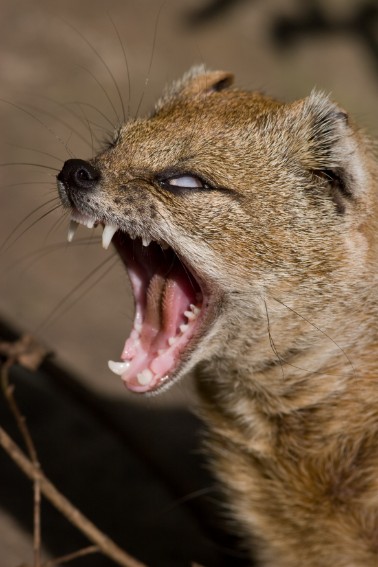 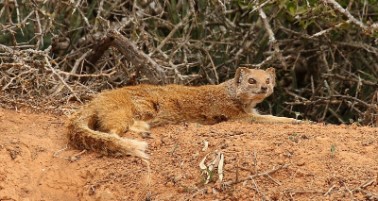 Diet The Yellow Mongoose is mainly an insectivore, but will eat just about anything. It has a varied diet which consists of: Beetles, ants, termites, larvae, locusts, caterpillars, mice, small birds, rodents, grass, frogs, eggs, lizards, geckos, seeds, toads, centipedes, crickets, small baby mammals, snakes, cobras and meat from unattended or unguarded carcesses. The Yellow Mongoose will dig for its food, but prefers to catch prey on the surface using its rapid agility and good eye sight. This speed is put to good use when facing venomous snakes; some species of mongoose have some immunity to venom, but the resistance in the Yellow Mongoose is yet to be researched. They are oppotunists and will not hesitate to engage a cobra or take meat from a deceased or killed creature (pictured). In spite of the fact that Yellow Mongooses live in groups, they prefer to forage alone or in pairs. This is to avoid competition over food, but it does make them more vulnerable to predators. 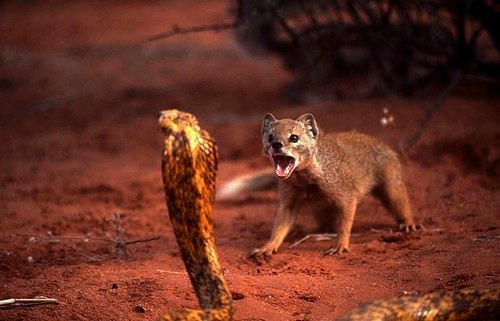 Reproduction Breeding in the yellow mongoose society is seasonal and takes place in July to September. Most individuals choose to breed during July, to coincide with Spring, when food is at its most abundant. Courtship includes purring, nuzzling, licking and biting of the neck and ears. Evetually the pair will concieve, which lasts from 30 seconds to a minute. In August to November, or sometimes January, after a relatively short gestation of 42 - 57 day (average of 56 days), the female gives birth in a clear burrow chamber. Yellow Mongoose litters usually consist of two pups, but size ranges from 1 - 5 young, but considering female yellow mongooses have six teats, it could be possible that litters can reach as many as six siblings. Whether pups are born hairless or blind is yet to be determined. The non-breeding sub adults of the group assist in raising the offspring, whom are weaned at 10 weeks old, are fully grown at 10 months of age and reach sexual maturity at 730 days. It is not known if the father helps to guard and feed his charges, there is still much to learn about the behaviour in Yellow Mongooses when it comes to rearing pups. 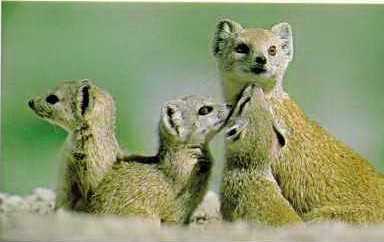 Territorial Behaviour To prevent competition for food resources, Yellow Mongooses establish ranges in which they mark using a powerful stench from their anal glands, fur, salivia, urine, feaces and scent from their cheeks. Dominant males in a group also use these methods to claim a mongoose as a part of his colony. Everyday, usually when the group emerges, he will anal-wipe the members to remind them who's in charge, but more importantly to signal which group the mongoose belongs to, so if they were seperated over a prolonged amount of time the family would be able to recognise the smell and re-accept the member back into the group. 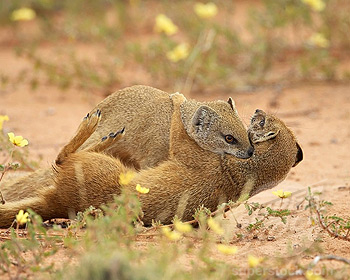 In the Media
On the Television Comrades of the Kalahari: The only documentary based almost entirely on the yellow mongoose. Part of the Natural World series, this 1994 program looks at the co-operation of yellow mongooses and the competition they face. Meerkat Manor: In season 2 a yellow mongoose was seen drinking at a water trough and, in another episode, leaving its burrow. In the fourth season a Yellow Mongoose was evicted from its den by a meerkat group, it later challenged the group's male meerkat, but lost in a brief-contact fight. Nigel Marven Meerkat Adventure: At one point it featured a yellow mongoose catching and eating a lizard. Lions of the Kalahari: A red-coloured yellow mongoose was breifly seen. BMW Ad: A yellow mongoose made a short appearence in a BMW car advertisement, set in South Africa. On the Internet Yellow Mongoose Check-Up: In 2009 London Zoo performed a health check on a yellow mongoose and images of the experience were released all over the internet. Zoo World: A popular Facebook game includes a Yellow Mongoose that can be purchased. Zoo Tycoon 2: A popular PC game, a website included a free download of the Yellow Mongoose for users (link to the download can be found on the Link page) Mongoose VS Cobra: In 2010 incredible photos of a yellow mongoose contronting a Cape Cobra were released onto the intenet. The images are courtesy of Paul Brehem. |
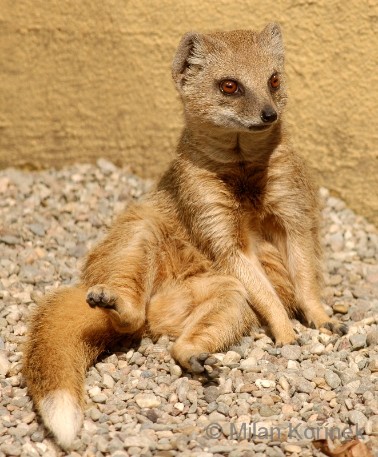 Appearence This mongoose species has a white tip on the end of its bushy tail, round ears, rectangular-pupil eyes with an additional membrane lid (pictured), 5 toes on their footfeet with small black claws and furless pads, 4 clawed-toes on their backfeet (unlike their forefeet, the hind feet are hairy), a light yellow or white muzzle, sharp canine teeth, whiskers and a gold, yellow, red, or grey coat. The colour of their fur depends on their location and sub-species. Twelve seperate sub-species have been identified; Cynictis penicillata bechuanae
 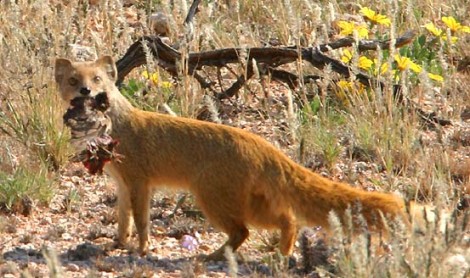 Predators Given its small size, the yellow mongoose has many predators to watch out for, including large birds of prey, particually the Martial Eagle and Tawny Eagle, Black-backed Jackals, which can dig up a yellow mongoose in a shallow burrow, and snakes, especially the Cape Cobra (pictured). Yellow Mongoose pups are at a greater risk, given their even smaller size and vulnerability, they can fall prey to other predators such as hawks, foxes, monitor lizards and caracals. 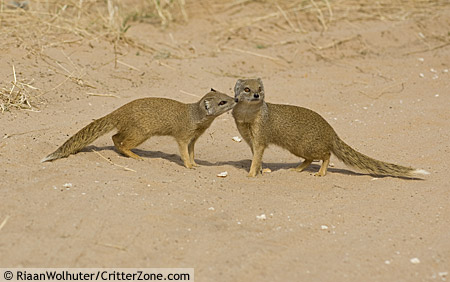 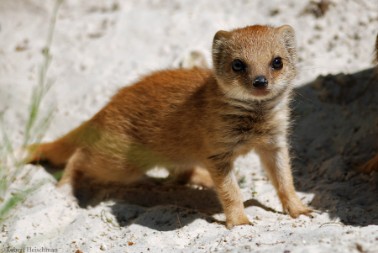 Communication Yellow Mongooses generally use tail movements to communicate to others (swishing, flicking, erecting) but occasionally use their vocals. When copulating the pair may purr to each other, males often purr more frequently than females, and if threatened or angered they can growl and emit a screech to warn or scare off the enemy. Yellow Mongooses can also bark when playful or alarmed, but most of the time they're silent.
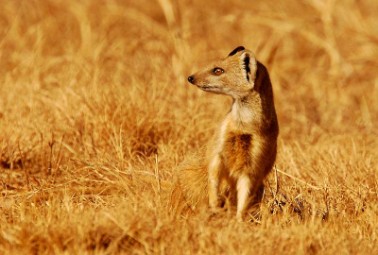 Human Interaction In some African societies, Yellow Mongooses are greatly appreciated as they control insect, rodent and snake populations. But, unfortunately, most people whom share their land with the animal despise it. Yellow Mongooses are one of Africa's most reknowned rabies-carrier. It is believed they can carry infectious rabies for years without dying, unlike other creatures, and that finding symptoms of the disease in the Yellow Mongoose is difficult. Because of this, farmers willingly set lethal traps or gas them inside their burrows, in defense of vulnerable people and livestock. Unfortunately, nothing or very little is being done to conserve the Yellow Mongoose.  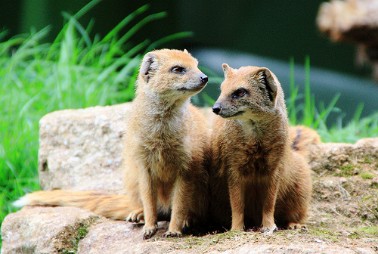 |
|